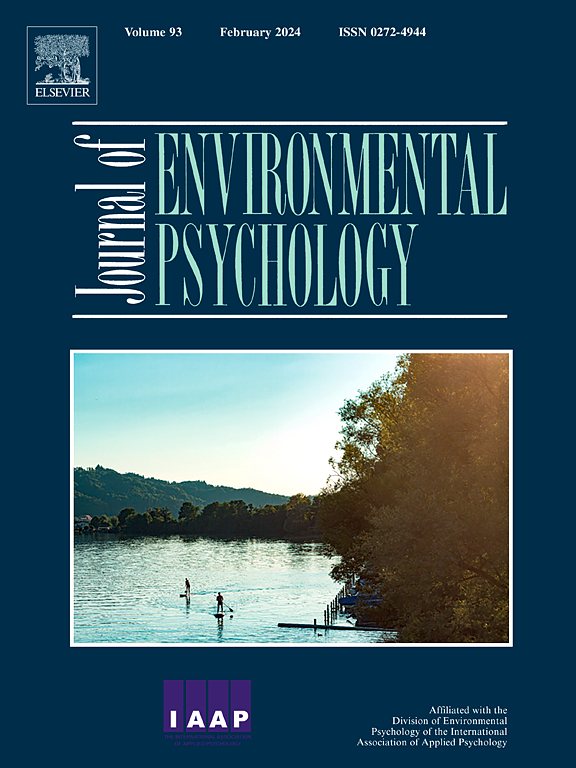意大利儿童对自然的看法:绘画中环境主题的聚类分析
IF 7
1区 心理学
Q1 ENVIRONMENTAL STUDIES
引用次数: 0
摘要
本研究探讨了意大利小学生如何通过绘画表现自然。意大利北部公立小学三年级至五年级的2997名学生(年龄9-11岁,50.4%为女性)参与了方便样本。每个孩子完成了两幅画:一幅描绘了现在的自然,另一幅描绘了未来的自然。内容分析揭示了一种描绘环境问题的倾向,以及对未来自然的大部分负面看法。聚类分析确定了五种不同的代表性特征,“平衡现实主义者”(30%)最为普遍,“技术未来主义者”(10%)最少。性别差异出现了:女性更倾向于描绘环境退化和生物元素,而男性更倾向于描绘城市和技术特征。一项探索性的主题内分析进一步表明,虽然一些孩子在两个时间框架内保持一致的取向,但许多孩子从对现在的中性或积极描述转变为对未来的消极描述。这些发现强调了将儿童的环境观念纳入教育计划以培养生态意识和可持续思维的重要性。讨论了研究的局限性和未来的研究方向。本文章由计算机程序翻译,如有差异,请以英文原文为准。
Italian children's visions of nature: A cluster analysis of environmental themes in drawings
The present study explores how Italian primary school children represent nature through drawing. A convenience sample of 2997 students (aged 9–11; 50.4 % female) from grades 3 to 5 in public elementary schools in northern Italy participated. Each child completed two drawings: one illustrating nature in the present and one envisioning nature in the future. Content analysis revealed a tendency to depict environmental issues and a largely negative view of nature in the future. A cluster analysis identified five distinct representational profiles, with “Balanced Realists” (30 %) being the most prevalent and “Technological Futurists” (10 %) the least. Gender differences emerged: females were more likely to portray environmental degradation and biotic elements, while males favored urban and technological features. An exploratory within-subject analysis further showed that while some children maintained consistent orientations across both time frames, many shifted from neutral or positive depictions of the present to negative depictions of the future. These findings highlight the importance of incorporating children's environmental perceptions into education programs to foster ecological awareness and sustainable thinking. Study limitations and future research directions are discussed.
求助全文
通过发布文献求助,成功后即可免费获取论文全文。
去求助
来源期刊

Journal of Environmental Psychology
Multiple-
CiteScore
10.60
自引率
8.70%
发文量
140
审稿时长
62 days
期刊介绍:
The Journal of Environmental Psychology is the premier journal in the field, serving individuals in a wide range of disciplines who have an interest in the scientific study of the transactions and interrelationships between people and their surroundings (including built, social, natural and virtual environments, the use and abuse of nature and natural resources, and sustainability-related behavior). The journal publishes internationally contributed empirical studies and reviews of research on these topics that advance new insights. As an important forum for the field, the journal publishes some of the most influential papers in the discipline that reflect the scientific development of environmental psychology. Contributions on theoretical, methodological, and practical aspects of all human-environment interactions are welcome, along with innovative or interdisciplinary approaches that have a psychological emphasis. Research areas include: •Psychological and behavioral aspects of people and nature •Cognitive mapping, spatial cognition and wayfinding •Ecological consequences of human actions •Theories of place, place attachment, and place identity •Environmental risks and hazards: perception, behavior, and management •Perception and evaluation of buildings and natural landscapes •Effects of physical and natural settings on human cognition and health •Theories of proenvironmental behavior, norms, attitudes, and personality •Psychology of sustainability and climate change •Psychological aspects of resource management and crises •Social use of space: crowding, privacy, territoriality, personal space •Design of, and experiences related to, the physical aspects of workplaces, schools, residences, public buildings and public space
 求助内容:
求助内容: 应助结果提醒方式:
应助结果提醒方式:


